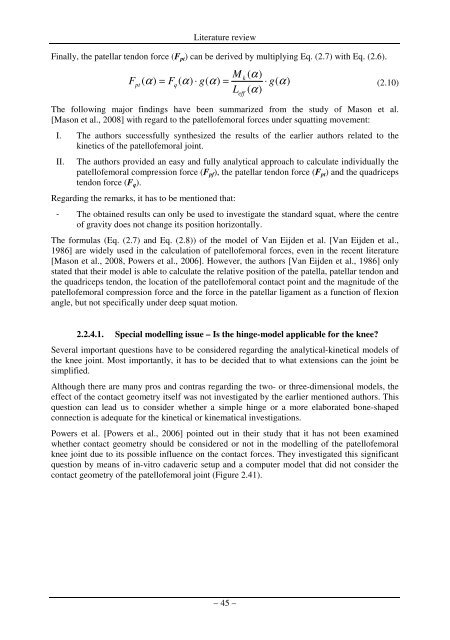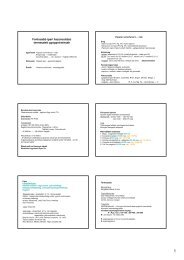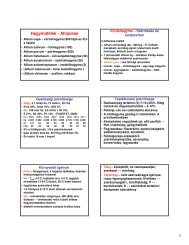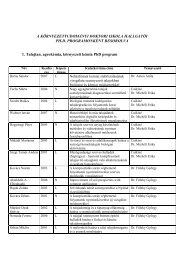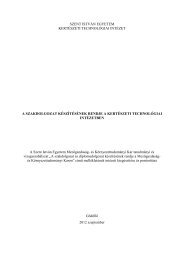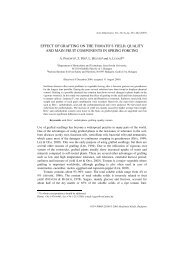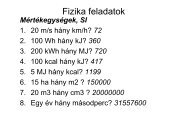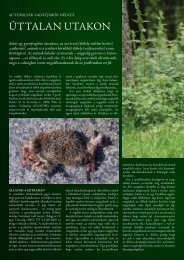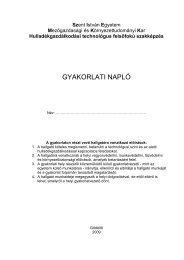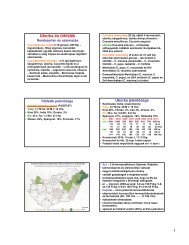PhD Fekete - SZIE version - 2.2 - Szent István Egyetem
PhD Fekete - SZIE version - 2.2 - Szent István Egyetem
PhD Fekete - SZIE version - 2.2 - Szent István Egyetem
Create successful ePaper yourself
Turn your PDF publications into a flip-book with our unique Google optimized e-Paper software.
Literature review<br />
Finally, the patellar tendon force (F pt ) can be derived by multiplying Eq. (2.7) with Eq. (2.6).<br />
F<br />
pt<br />
M<br />
k<br />
( α)<br />
( α)<br />
Fq<br />
( α)<br />
⋅ g(<br />
α)<br />
= ⋅ g(<br />
α)<br />
L ( α)<br />
= (2.10)<br />
The following major findings have been summarized from the study of Mason et al.<br />
[Mason et al., 2008] with regard to the patellofemoral forces under squatting movement:<br />
I. The authors successfully synthesized the results of the earlier authors related to the<br />
kinetics of the patellofemoral joint.<br />
II.<br />
The authors provided an easy and fully analytical approach to calculate individually the<br />
patellofemoral compression force (F pf ), the patellar tendon force (F pt ) and the quadriceps<br />
tendon force (F q ).<br />
Regarding the remarks, it has to be mentioned that:<br />
- The obtained results can only be used to investigate the standard squat, where the centre<br />
of gravity does not change its position horizontally.<br />
The formulas (Eq. (2.7) and Eq. (2.8)) of the model of Van Eijden et al. [Van Eijden et al.,<br />
1986] are widely used in the calculation of patellofemoral forces, even in the recent literature<br />
[Mason et al., 2008, Powers et al., 2006]. However, the authors [Van Eijden et al., 1986] only<br />
stated that their model is able to calculate the relative position of the patella, patellar tendon and<br />
the quadriceps tendon, the location of the patellofemoral contact point and the magnitude of the<br />
patellofemoral compression force and the force in the patellar ligament as a function of flexion<br />
angle, but not specifically under deep squat motion.<br />
eff<br />
<strong>2.2</strong>.4.1. Special modelling issue – Is the hinge-model applicable for the knee?<br />
Several important questions have to be considered regarding the analytical-kinetical models of<br />
the knee joint. Most importantly, it has to be decided that to what extensions can the joint be<br />
simplified.<br />
Although there are many pros and contras regarding the two- or three-dimensional models, the<br />
effect of the contact geometry itself was not investigated by the earlier mentioned authors. This<br />
question can lead us to consider whether a simple hinge or a more elaborated bone-shaped<br />
connection is adequate for the kinetical or kinematical investigations.<br />
Powers et al. [Powers et al., 2006] pointed out in their study that it has not been examined<br />
whether contact geometry should be considered or not in the modelling of the patellofemoral<br />
knee joint due to its possible influence on the contact forces. They investigated this significant<br />
question by means of in-vitro cadaveric setup and a computer model that did not consider the<br />
contact geometry of the patellofemoral joint (Figure 2.41).<br />
– 45 –


